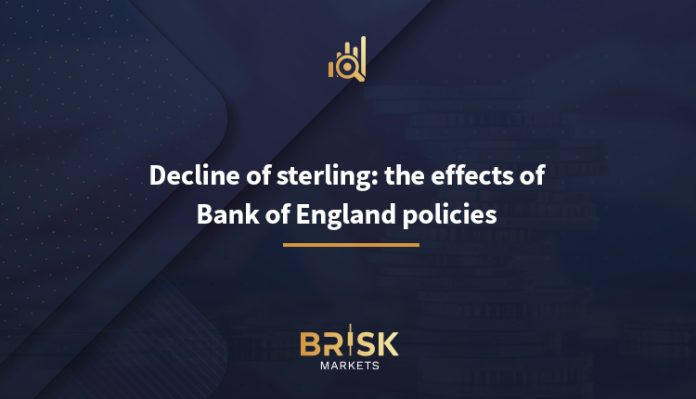The value of the pound sterling declined today, Wednesday, after achieving noticeable gains in the previous session, which is the largest rise in one day in four months, as a result of the weak report on monthly US business activity, which negatively affected the dollar.
The value of the British pound to $1.2435, after rising 0.8% in the previous session, the largest rise since mid-December . While the value of the euro stabilized against the pound at 85.99 pence.
The pound sterling was under pressure this week, after reaching its lowest level since November at the beginning of the week, due to statements by officials at the Bank of England indicating expectations of a decline in inflation in the United Kingdom, indicating the possibility of lowering interest rates more quickly than the market currently expects.
In this context, the Governor of the Bank of England, Andrew Bailey, stated last week that inflation in Britain is declining according to the expectations of the central bank, while Monetary Policy Committee member Dave Ramsden, who recently voted in favor of keeping interest rates as they are, indicated that the risk of rising pressures has decreased. On prices.
Reflecting market expectations of interest rate cuts at the Bank of England’s August meeting and again at the end of the year, traders believe about 40% of a cut in June, which is in line with the views of about half of the economists surveyed by Reuters on Wednesday.
In this context, a currency strategist indicates that the decision to cut interest in June may be soon, but it indicates challenges facing the Monetary Policy Committee in obtaining the necessary majority to make this decision in the coming months, which requires adopting a positive stance towards inflation by many members.
Expectations of a devaluation of the British pound: the impact of Bank of England policies
Expectations for a devaluation of the British pound in the last quarter of 2023 are largely linked to the Bank of England’s interest rate policies, with this analysis predicting its impact on three GBP pairs.
The GBP/USD pair is expected to face challenges as a result of the superiority of the US dollar, which plays a decisive role in the foreign exchange market and will have an important influence in determining the course of the British pound in the future.
Bank of England chief economist Huw Bell, in his speech on Tuesday, expressed concern about the prospect of early interest rate cuts, suggesting that the date of the first cut “may be relatively far away.”
The difficulties facing the situation are highlighted, as a survey of manufacturers’ purchases on Tuesday revealed a rapid rise in business activity in Britain at a rate not seen in almost a year, despite the rise in the input price index to its highest level since last May.
The Bank of England is paying close attention to wage growth too.
The results of an industry survey on Wednesday showed that British employers reached higher basic settlements with employees in the three months to the end of March, up 4.8% on the previous year, although slowing to the February rate of 5%.
Before any decision to cut interest rates, most Bank of England policymakers would prefer to see signs that annual wage growth is returning to a range of 3% to 4%, compared to the recent 6% rate.
The Bank of England is expected to wait until next quarter to decide to lower the cost of borrowing, according to the median forecast in a Reuters poll, although about half of those polled believe the central bank will cut rates in June.
Declining inflation in the UK opens the door for interest rate cuts
Senior officials at the Bank of England – such as Governor Andrew Bailey and Deputy Governor Dave Ramsden – recently provided an assessment that UK inflation is falling, a development in line with the central bank’s expectations. This decline reduces the risk of inflation continuing at very high levels, and opens the door to the possibility of lower interest rates.
In March, British inflation was above the Bank of England’s 2.0% target, at 3.2%, but below February’s level of 3.4%. Banks take these factors into account when determining their monetary policy.
During the period from December 2021 to August 2023, the Bank of England raised borrowing costs by 515 basis points, the highest level in 16 years, to combat rising inflation that peaked in October 2022 at 11.1%.
Market expectations indicate that the interest rate will remain stable at its current level of 5.25% at the central bank meeting in May, with average expectations indicating the possibility of a first cut in the next quarter.
However, these forecasts were risky as nearly 48% of economists expected a cut in the third quarter, compared to 31% expecting a cut in June, showing the disparity in expectations among experts.
Banks that can bid directly in government bond auctions — known as gold-edged market makers (GEMMs) — were almost evenly split over the timing of the first cut.
When survey participants were asked about the timing of the first interest rate cut, 73% of them subsequently answered contrary to their previous expectations, while the remaining seven remained committed to their initial expectations.
Senior economists such as Sanjay Raja, chief economist at Deutsche Bank, believe that if inflation worsens in the coming months, interest rate cuts may be postponed again, which shows sensitivity and conservatism in making financial decisions in light of economic fluctuations.




